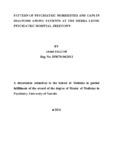| dc.contributor.author | Abdul, Jalloh | |
| dc.date.accessioned | 2016-11-18T07:41:21Z | |
| dc.date.available | 2016-11-18T07:41:21Z | |
| dc.date.issued | 2016 | |
| dc.identifier.uri | http://hdl.handle.net/11295/97536 | |
| dc.description.abstract | Background: Mental health is an essential and integral component of health. Sierra Leone,
which emerged from decade-long civil war and recently suffered from the worst outbreak of
Ebola virus, left many citizens of the nation mentally traumatized with high incidences of
undiagnosed mental disorders. Timely and accurate diagnosis of mental health problems is
essential in the management of these diseases. The pattern of psychiatric conditions in the
hospital is not well known with little available data derived from WHO estimates.
Aim: The study was designed to determine the pattern of psychiatric morbidities and gaps in
diagnosis among patients at the Sierra Leone Psychiatric Hospital, Freetown.
Study Design: The study employed a hospital based descriptive cross-sectional survey.
Method: 385 patients were screened for eligibility and approached for informed
consent/assent. Patients working diagnosis was abstracted from patient charts and
interviewed using M.I.N.I. Plus and researcher designed socio-demographic questionnaire.
Comparisons made between working and M.I.N.I. Plus diagnosis.
Results: A total of 385 patients interviewed. Over two-thirds (66%) were males and 34%
females. The majority was in the 15 to 19 years (19%) and 20 to 24 years (20%) age groups
with 41% had Family History of Mental Illness and 45% on their first admission. Drug
Induced Psychosis, SUD, and Psychotic disorder were mainly the diagnosis on patient's
charts with a substantial proportion (17.7%) undefined. M.I.N.I. Plus diagnosed all patients
with the psychotic disorder the most common (74%), followed by Alcohol used disorder
(AUD), Substance used disorder (SUD) and Post-traumatic stress disorder (PTSD). It was
observed that 91% had more than one psychiatric morbidities and variation between
diagnosis in patient's charts and diagnosis by MINI Plus with 23.1% SUD, 22.8% psychotic
disorder, 9.5% major depression, 3.8% AUD and 0.5% of mania accurately diagnosed.
Conclusion: The M.I.N.I. Plus revealed different types and patterns of psychiatric
morbidities, comorbidities with a majority having more than psychiatric morbidities and
observed significant discrepancies between working and M.I.N.I. Plus diagnosis with a
majority of patients inaccurately diagnosed and substantial proportion with an undefined
diagnosis.
Recommendations: These results call for the training of all mental health workers on the
routine use of screening and diagnostic tools to help in improving patient management. | en_US |
| dc.language.iso | en | en_US |
| dc.publisher | University of Nairobi | en_US |
| dc.rights | Attribution-NonCommercial-NoDerivs 3.0 United States | * |
| dc.rights.uri | http://creativecommons.org/licenses/by-nc-nd/3.0/us/ | * |
| dc.title | Pattern of psychiatric morbidities and gaps in diagnosis among patients at the Sierra Leone psychiatric hospital, Freetown | en_US |
| dc.type | Thesis | en_US |
| dc.description.department | a
Department of Psychiatry, University of Nairobi, ; bDepartment of Mental Health, School of Medicine,
Moi University, Eldoret, Kenya | |



